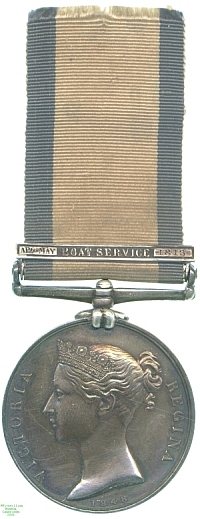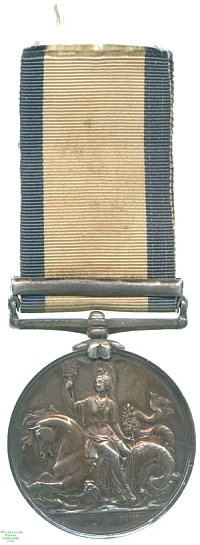
Obverse, a bust of Queen Victoria

Reverse, Britannia with a trident seated sideways on a seahorse

Obverse, a bust of Queen Victoria |

Reverse, Britannia with a trident seated sideways on a seahorse |
Just as in 1848 the extensive land campaigns of the Napoleonic Wars and the other conflicts of the pre-Victorian era were recognised by the issue of the Miltary General Service Medal, those serving in the Navy at the time were recognised with the Naval General Service Medal. As with the Army equivalent and the East India Company's related award, many of the battles for which the medal was awarded had been fought so long ago that few if any claimants survived.
In addition, bars were awarded for many actions whose significance and size were, despite the heroism displayed by those involved, relatively minor. The result was that many of the bars were issued in tiny numbers, with some combinations all but unique, and the medals command a very high price among collectors because of this rarity and individuality. This in turn, along with the manufacture in most cases of more bars than were eventually issued, has led to the `improvement' of many common awards where recipients' names are shared with those present at `rarer' battles. The medal also shares with the Military General Service and Army of India Medals the oddity that Queen Victoria, whose portrait they bear, was not the ruler under whom the battles for which it was awarded were fought.
Some of the smallest actions for which the NGSM was awarded were fought not from ships, but from ships' boats, combats which could on occasions be no less dangerous or destructive than ship-to-ship battles. This bar was given for two separate actions on the Elk River in Chesapeake Bay, in which landing parties from 8 Royal Navy vessels went upriver to destroy United States ships and stores; they sank five vessels in the first engagement, at Frenchtown (the night of 29 April), and on their return down the river on 3 May were fired upon by a US battery at Havre-de-Grace and therefore landed and destroyed it.
Early recipients of the NGSM with this clasp received one that read "29 April Boat Service 1813" but as a similar clasp had already been issued for a different battle the one for these engagements was rapidly revised to the version seen here, which was awarded to Lieutenant G. Bishop, of the 38-gun 5th-rate frigate HMS Statira. The presence of such a man aboard the vessel at this time is verified, and the Medals Roll confirms the award of the piece to him. Lester Watson purchased the medal from the dealer Gifford at some point before 1928; it had previously been auctioned at the London house of Glendining in January 1903.